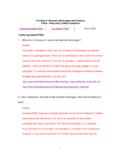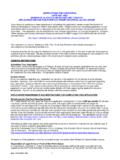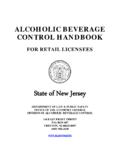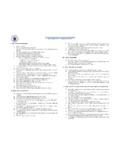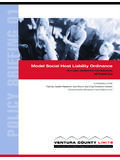Transcription of A REVIEW OF THE TAXATION OF ALCOHOLIC …
1 1 A REVIEW OF THE TAXATION OF ALCOHOLIC BEVERAGES IN SOUTH AFRICA A Discussion Document May 2014 Economics Tax Analysis Chief Directorate 2 Table of Contents EXECUTIVE SUMMARY .. 4 1. INTRODUCTION .. 9 2. CURRENT SOUTH AFRICAN ALCOHOL EXCISE TAX REGIME .. 12 a) Current alcohol excise duty policy approach .. 12 b) Experience with the current alcohol excise regime .. 13 c) Illicit trade and smuggling of ALCOHOLIC beverages .. 16 3. DIFFERENTIAL ALCOHOL EXCISE TAXATION .. 17 a) Relative tax rates between types of ALCOHOLIC beverages.
2 17 b) South Africa s current differential rates system .. 18 c) Classification of ALCOHOLIC beverages .. 19 4. INTERNATIONAL COMPARISONS .. 25 a) Updated BAC (Brewers Association of Canada) international benchmarks .. 25 b) OECD country comparison .. 26 c) South-East Asian country comparison .. 28 d) Southern African country comparison .. 29 5. EXTERNAL COSTS ASSOCIATED WITH ALCOHOL ABUSE .. 30 a) Sectoral estimates by national / provincial departments .. 32 b) Summary of expenditure on alcohol abuse .. 37 c) Internalising the external cost associated with alcohol abuse.
3 39 6. NON-TAX INTERVENTIONS .. 41 a) Alcohol pricing .. 42 b) Alcohol availability .. 44 c) Drinking and driving .. 46 d) Education and awareness .. 47 e) Drinking environment .. 49 f) Other .. 51 7. ECONOMIC OVERVIEW OF ALCOHOLIC BEVERAGES SECTOR .. 54 a) Total ALCOHOLIC beverages sector .. 54 b) Wine industry .. 57 c) Malt beer industry .. 60 d) Spirits and ready-to-drink industries .. 61 e) Summary of economic overview by sector .. 63 3 8. ILLICIT TRADE .. 64 a) Nature of illicit trade .. 64 b) Illicit trade in wine, spirits and beer .. 66 c) Trade in sugar fermented beverages / illicit ales.
4 67 d) Combating illicit trade .. 69 e) SADC investigation and initiatives .. 69 9. ESTIMATES OF THE ELASTICITIES OF DEMAND .. 71 a) Elasticities of demand for ALCOHOLIC beverage products .. 71 b) Elasticity of demand estimates per liquor product category .. 73 10. POLICY CONSIDERATIONS AND OPTIONS .. 77 a) Coordination between tax and non-tax measures .. 79 b) Coordination and alignment of legislation regulating the alcohol industry .. 80 c) Is an alignment of alcohol excise taxes across alcohol product types possible? .. 81 d) Alcohol excise duties relating to Ciders, ALCOHOLIC Fruit Beverages (AFBs) and Spirit Coolers.
5 85 e) Maintenance of targeted benchmarks for alcohol consumption taxes .. 87 f) Inflation plus adjustments to alcohol excise duty rates .. 88 11. REFERENCES .. 89 ANNEXURE A: OECD ALCOHOL DUTY TRENDS .. 97 ANNEXURE B: VOLUME AND ABSOLUTE ALCOHOL CONTENT .. 100 4 EXECUTIVE SUMMARY The Minister of Finance announced in the 2010 Budget REVIEW his intention to REVIEW the excise duties structure of ALCOHOLIC beverages. This discussion document analyses the experience of the current excise duty structure for ALCOHOLIC beverages since its implementation in 2002, recent developments in excise policy formulation both locally and internationally, and the scope of using the excise duty system to internalise the social external costs arising from alcohol abuse.
6 Consultations since 2010 elicited contributions from government, industry, and other stakeholders helped inform this REVIEW . Current alcohol excise tax regime South Africa applies a transparent alcohol excise duty rate structure that differentiates between ALCOHOLIC beverages in accordance with benchmarks determined in 2002 and adjusted in 2012. The total consumption tax burden (excise duties plus VAT) as a percentage of the weighted average retail selling price for wine, clear beer and spirits were set at 23, 33, and 43 per cent respectively in 2002.
7 Budget 2012 increased the target tax burden for beer and spirits to 35 and 48 per cent respectively. Alcohol excise duties were increased above inflation since 2002/03 to achieve and maintain the targeted indirect tax burdens on ALCOHOLIC beverages. Differential alcohol excise TAXATION Appropriate excise rates for different types of ALCOHOLIC beverages need to be informed by a combination of factors that include, attempts to address the social and health concerns of alcohol abuse, comparisons with international benchmarks, local conditions of the various ALCOHOLIC beverages industries and markets, absolute alcohol content, and social and political perceptions and values.
8 Besides revenue raising objectives, the rationale for excise taxes on ALCOHOLIC beverages is to reflect their harmful external costs. Since these are primarily related to the volume of alcohol rather than the type of alcohol beverage , some argue that alcohol taxes should be based on ALCOHOLIC content. In practice, the TAXATION of ALCOHOLIC beverages often deviates from alcohol content and to differentiate between beer, wine and spirits based on health and social considerations, price elasticities, alcohol concentration, and special considerations related to the domestic wine industry, and the practise to tax hard liquor (spirits) at higher rates.
9 Concerns with the current ALCOHOLIC beverage tax regime include the need to update the current benchmarks, anomalies in the ready-to-drink (RTD), cider, and ALCOHOLIC fruit beverages (AFB) beverage market, structural changes in 5 ALCOHOLIC beverages market, the appropriate classification and TAXATION of mixed and fermented ALCOHOLIC beverages, and the displacement of some lower priced products into the illegal sector. Technological advances in production techniques and product development on the traditional demarcation / classification and TAXATION of ALCOHOLIC beverages.
10 International trends Internationally there is no straight-forward relationship between tax rates and alcohol consumption levels, as a range of psychological and cultural considerations influence alcohol consumption. Rates of alcohol TAXATION tend to differ much more widely between countries than any reasonable variance in estimates of social costs of alcohol abuse. International comparisons of alcohol TAXATION tend to reflect country-specific histories, revenue needs and in some instances protectionism and not necessarily the true or reasonable estimate of external cost.










